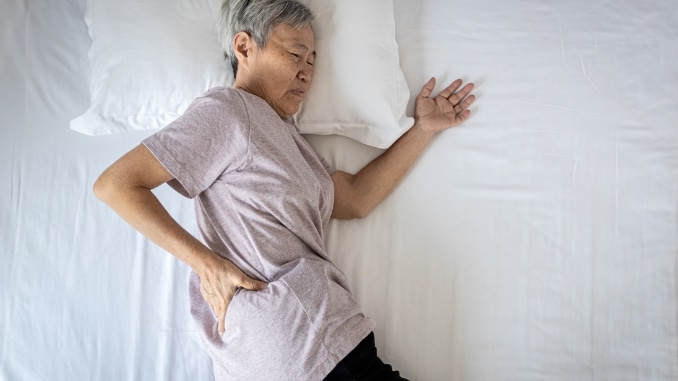Struggling with hip pain at night? If you’ve ever tossed and turned, unable to get comfortable, you know exactly what I mean.
Hip pain at night can stem from various causes, including hip osteoarthritis. The pain from hip osteoarthritis (OA) [1] doesn’t discriminate—it can happen whether you’re in the early or later stages of the condition.
But here’s the kicker: if you’re a woman [2] with severe hip pain, your sleep could get worse, especially after the first couple of hours of rest.
Let’s dive into why this happens and how you can finally get a better night’s sleep.
Best Hip Stretches to Do Before Bed
1. Seated Spinal

- Begin in an upright sitting position on a yoga mat, with one leg extended straight in front of you and the opposite leg bent, crossing the foot over the extended leg.
- Place your opposite arm outside the bent knee and the other hand on the floor behind you for support.
- Engage your core and gently twist your upper body toward the bent knee.
- Keep your spine long and avoid forcing the stretch.
- Hold this position for several deep belly breaths, in through your nose and out through your mouth.
- Slowly return to the starting position and repeat the movement on the opposite side.
2. Knee to Chest Stretch
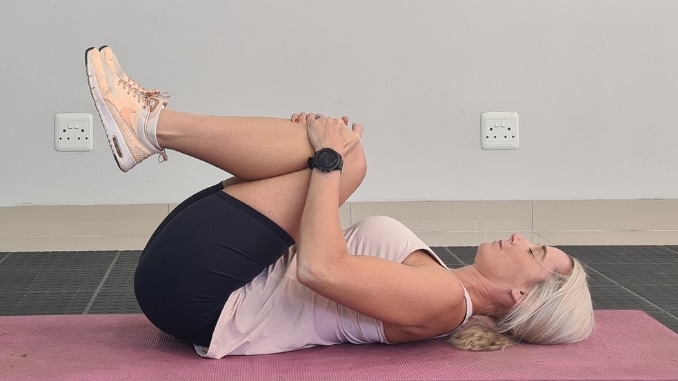
- Lie on your back with your knees bent and your feet flat on the floor.
- Raise both legs, holding your lower leg with both hands.
- Pull your knee closer to your chest to intensify the stretch.
- Hold the position for several deep belly breaths, in through your nose and out through your mouth.
- Relax, return to the starting position, and repeat the movement on the opposite side.
3. Seated Figure
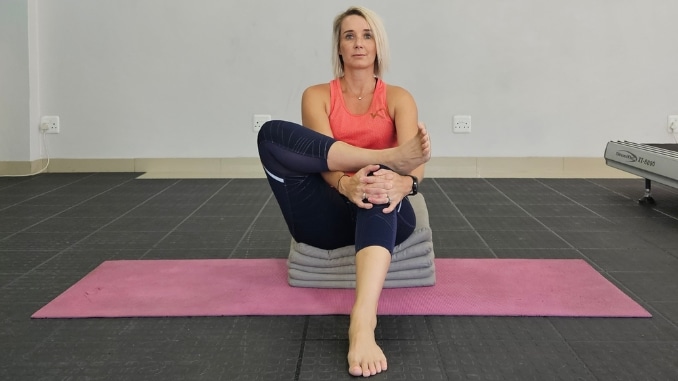
For this exercise, use a pillow or a blanket for support.
- Begin in an upright sitting position on a pillow, while maintaining good alignment of your head, shoulders, and hips.
- Engage your core and place your left ankle either just above or below the right knee.
- For an added challenge and to target your core, bend your left leg with the foot flat on the floor, then grasp your left knee with your hands clasped together underneath.
- Hold the position for several deep belly breaths, in through your nose and out through your mouth.
- Relax and repeat the movement on the opposite side.
4. Butterfly Stretch
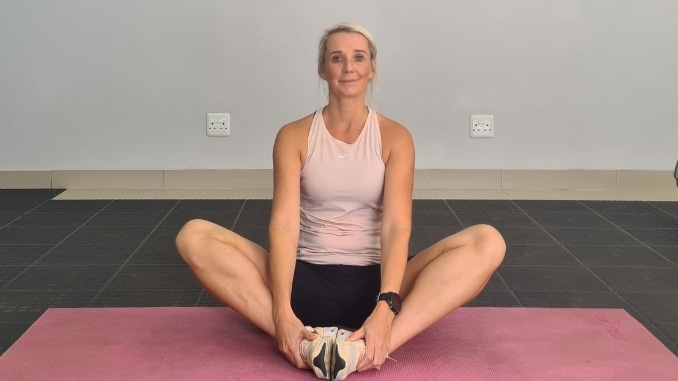
- Begin in an upright sitting position on the floor with your knees bent and feet flat on the floor.
- Bring the soles of your feet together and straighten your spine.
- Engage your core.
- Hold your feet and let your knees drop toward the floor to stretch the inner thighs.
- Hold this position for several deep belly breaths, in through your nose, out through your mouth.
- Return to the starting position and repeat the movement.
5. Double Hip Rotation
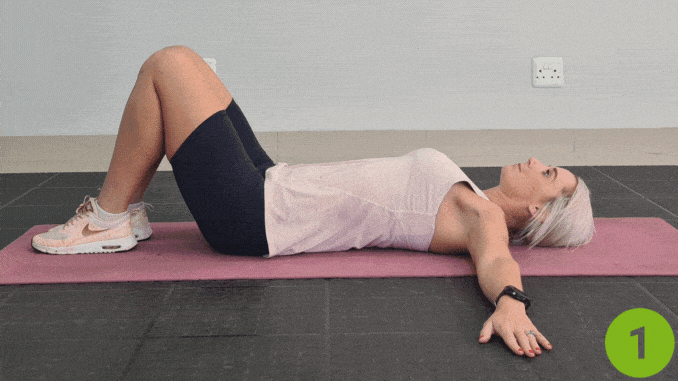
- Lie on your back with your knees bent and feet flat on the floor, about hip-width apart.
- Stretch your arms out to the sides for support.
- Gently lower both knees to one side, keeping your upper back on the floor.
- Pause and take a few deep belly breaths in through your nose and out through your mouth.
- Slowly return your knees to the center, then lower them to the other side.
- Move gently and smoothly.
- Repeat the movement side to side, holding each stretch for a few breaths.
- This helps relax your hips and lower back before bed.
6. Lunge Stretch (Low Lunge)
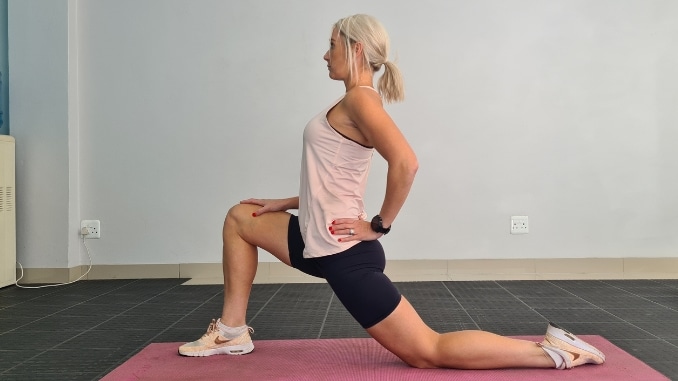
- Begin in an upright standing position, maintaining good alignment with your head, shoulders, and hips.
- Step one foot forward and lower your hips until both knees are bent at about a 90-degree angle, with your back knee resting on the floor.
- Place your hands on your hips or your front thigh for support.
- Hold this position for several deep belly breaths, in through your nose and out through your mouth.
- Push back to the starting position and repeat the movement 10-15 times on each leg.
Common Causes of Hip Pain at Night
- Osteoarthritis – Wear and tear of the joint, often leading to stiffness and pain.
- Rheumatoid Arthritis – An autoimmune condition that causes inflammation in the hip joint, leading to pain and swelling. Pain and stiffness at night [3] and in the early morning are significant contributors to suffering, particularly in conditions such as rheumatoid arthritis and osteoarthritis.
- Fractures – Hip fractures, especially in older adults, can result in significant pain, especially during movement or weight-bearing.
- Labral Tears – Tears in the cartilage of the hip joint can cause pain, instability, and clicking sensations.
- Avascular Necrosis – A condition where poor blood flow causes bone death, often resulting in hip pain. It’s common in those with a history of alcohol use, steroid use, or sickle cell anemia.
- Infections – Bacterial or viral infections affecting the hip joint or surrounding areas can cause pain, redness, and swelling.
- Gout – A type of arthritis caused by the buildup or uric acid crystals in the joints, leading to sudden and intense hip pain.
- Bursitis – Inflammation of the fluid-filled sacs (bursae) around the hip can cause pain, especially with movement.
- Tendonitis – Inflammation of the tendons around the hip joint, often caused by overuse, can lead to hip pain.
- Sciatica – Pain radiating from the lower back down to the hip and leg, caused by irritation of the sciatic nerve.
How to Relieve Hip Pain at Night

1. Find a Comfortable Sleeping Position
- Sleep on your back: Place a pillow under your knees to keep your hips aligned.
- Side sleeping: If you sleep on your side, place a pillow between your legs to reduce pressure on your hip joint.
2. Use a Heating Pad or Ice Pack
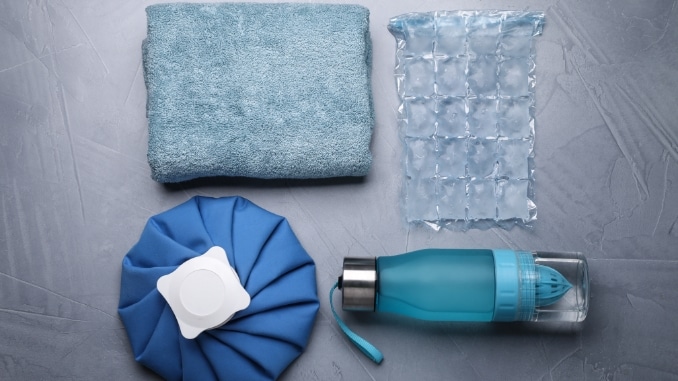
- Heat: Applying heat can help relax the muscles around your hip and soothe joint stiffness.
- Ice: If your hip pain is caused by inflammation, an ice pack may help reduce swelling and numb the pain.
3. Take Over-the-Counter Pain Relief
- Non-prescription medications, such as ibuprofen or acetaminophen, can help manage pain and inflammation before bedtime.
4. Gentle Hip Stretches Before Bed
- Stretching the hip flexors, hamstrings, and lower back gently before bedtime can reduce stiffness and promote better sleep.
5. Elevate Your Legs
Raising your legs slightly with a wedge or firm pillows can help reduce pressure on the hips and improve blood flow, which may ease discomfort.
6. Avoid Heavy Meals or Caffeine Late in the Day

Inflammation and poor sleep are closely connected. Eating clean and skipping stimulants in the evening may help reduce flare-ups.
7. Create a Wind-Down Routine
Dim the lights, power down screens, and commit to 10–15 minutes of relaxation—like stretching, journaling, or a warm bath—to signal your body it’s time to heal and rest.
When to See a Doctor
“Any kind of hip pain at rest, especially at night, is not normal and could be a sign of an injury or condition like hip bursitis or hip arthritis,” says Dr. Charen. “If your hip hurts while lying down or you’re dealing with persistent nighttime hip pain, it’s time to talk to your doctor and find the right treatment.”
- If hip pain wakes you up or interrupts your sleep regularly
- If you notice swelling, warmth, or redness in the hip area
- If your hip feels stiff or you’re losing range of motion
- If you have a history of joint issues, arthritis, or past injuries
- If over-the-counter pain relief no longer helps
- If the pain spreads to your groin, back, or down the leg
- If you hear clicking, popping, or feel instability in the hip
- If walking, climbing stairs, or standing becomes difficult
- If you’ve had recent trauma, like a fall or accident
- If you’re experiencing fever, chills, or unexplained weight loss alongside hip pain
Conclusion
Hip pain at night can be frustrating, but it’s also manageable with the right steps. From understanding the root causes—such as arthritis, injury, or inflammation—to adjusting your sleep position or incorporating simple stretches before bed, small changes can make a significant difference.
Stay consistent with your self-care routine, especially in the evening when your body needs support most.
Try a few gentle stretches tonight, and if the pain keeps you up, talk to a healthcare professional to get a personalized plan that helps you sleep (and feel) better.
If you are suffering from any sort of hip discomfort and want burning hip pain at night get rid of the soreness once and for all, then click here to check out the Best Gluteus Medius Exercises program.
Frequently Asked Questions
How do you relieve hip pain at night?
To relieve pain at night, try gentle stretching before bed, use a pillow between your knees if you sleep on your side, and avoid sleeping directly on the painful hip. Applying a warm compress may soothe lateral hip pain or outer hip pain. If hip bursitis or hip arthritis is the cause, physical therapy can help strengthen the area and improve sleep comfort. Talk to your doctor if the pain keeps waking you up.
What causes hip pain in bed?
Nighttime hip pain can be caused by pressure on the joint while lying down, poor mattress support, or medical issues like hip bursitis, hip arthritis, or upper thigh pain from inflammation or injury. When your hip hurts more at rest, it could signal stiffness, swelling, or irritation from overuse or age-related wear and tear.What is the best thing for hip pain?
What are the red flags of hip pain?
See a doctor right away if you experience:
- Severe pain that doesn’t improve
- Fever or redness (could signal infection)
- Inability to bear weight or walk
- Sudden swelling in the hip or upper thigh
- Numbness or tingling
- Pain that spreads beyond the lateral hip or outer hip
These may be signs of serious conditions beyond common hip bursitis or hip arthritis.

